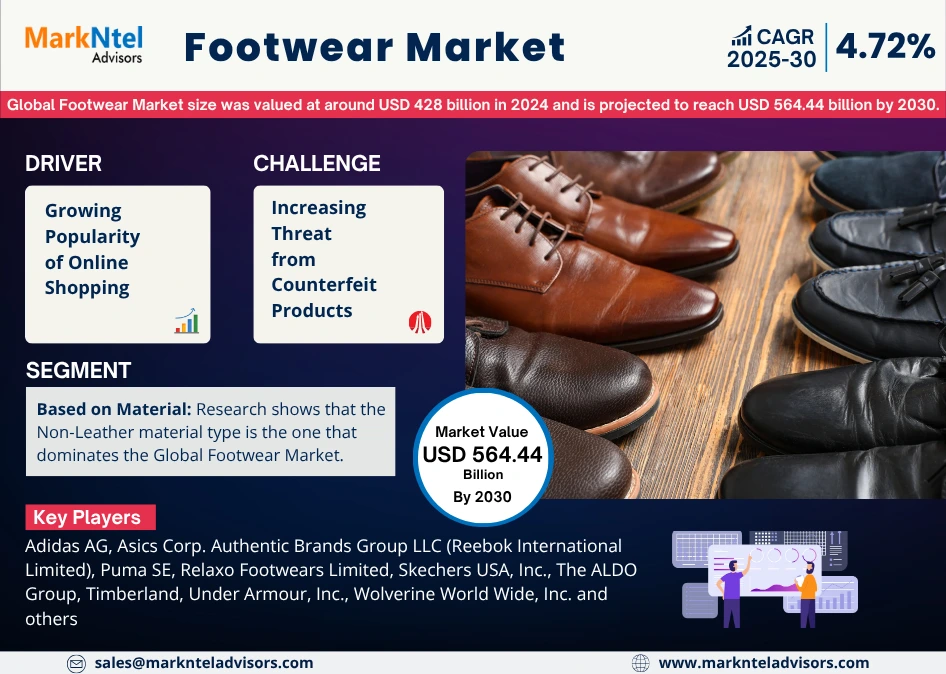Press Release Description
Footwear Market is Projected to Witness Lucrative Growth at a Steady CAGR of 4.72 by 2030
The Global Footwear Market size was valued at around USD 428 billion in 2024 and is projected to reach USD 564.44 billion by 2030. Along with this, the market is estimated to grow at a CAGR of around 4.72% during the forecast period, i.e., 2025-30, cites MarkNtel Advisors in the recent research report. The rise in popularity of social media and online shopping are two major drivers propelling the growth and expansion of the Global Footwear Market. Online platforms have made it easier and more accessible to purchase all types of footwear, and social media keeps everyone informed about the latest trends, which encourages additional purchases.
Moreover, personalization and customization have become a key trend in the footwear industry. This is driven by customer’s desire for personalized experience. Many brands now offer online customization options that help the customer to make their unique product suited to their taste. This trend is dominant in premium or high-end brands and products, including brands like Nike and Adidas, which enable customization through digital platforms. This not only increases customer loyalty but also gives a chance to brands to provide a tailored experience. As technology keeps on evolving the process of customization will also expand, offering customers even more options. Thus, personalization and customization are anticipated to change market dynamics and augment market size & volume in the coming years.
Despite a bright market outlook, there are some challenges to the growth & expansion of the Global Footwear Market. One of them is the counterfeiting of the products. Counterfeiting has become a very serious issue in the market mainly, affecting well-known brands. Counterfeit products that try to mimic bigger brands are usually sold at lower prices and attract a wide base of customers. This not only damages the bigger brand reputation but also negatively impacts customers who unknowingly buy these types of products. The rise of online platforms has also increased sales of counterfeited products as online platforms provide easy access to the sale of these products. In response, many brands are investing in anti-counterfeiting efforts to minimize the impact of such imitated products on their revenue growth, further states the research report, “Global Footwear Market Analysis, 2025.”

Global Footwear Market Segmentation Analysis
Non-Leather Material Type Seized the Largest Market Share
Based on the material type, the market is further bifurcated into Leather and Non-Leather materials. The non-leather segment currently leads the market with the largest share. Compared to leather, the non-leather material segment is more affordable and diverse. Non-leather fabric additionally offers advantages which include; flexibility, range, waterproof material, and ease of manufacturing, most of these related benefits attract customers to buy products of non-leather fabric. Unlike leather material, non-leather materials may be applied to create footwear with unique patterns, hues, and patterns. Despite being regarded as a high-end material; leather is neither low-budget nor environmentally beneficial. However, non-leather materials may be recyclable and environmentally benign, which helps maximize revenue from this market and eventually increases the size of the Global Footwear Market.
Asia-Pacific Leads the Global Footwear Industry
The data shows that throughout the forecast period, Asia-Pacific is expected to see robust sales growth. The availability of less expensive labor, the presence of well-known footwear manufacturers, the sizable pool of prospective buyers, etc., are the primary drivers of this anticipated sales boom. People's disposable income has been trending upward over the past few years, suggesting that they can spend money on premium products. In addition, a major portion of the populace in the Asia-Pacific region has smooth access to the Internet, allowing customers to buy products conveniently. This creates a wealth of profitable development potential for the leading footwear firms, enabling them to raise their sales and market share.
Competitive Landscape
With strategic initiatives, such as mergers, collaborations, and acquisitions, the leading market players, including Adidas AG, Asics Corp. Authentic Brands Group LLC (Reebok International Limited), Bata Corporation, Columbia Sportswear, Deichmann SE, ECCO Sko A/S, Fila Holdings Corp., Geox, Jack Wolfskin, New Balance, Nike Inc., Puma SE, Relaxo Footwears Limited, Skechers USA, Inc., The ALDO Group, Timberland, Under Armour, Inc., Wolverine World Wide, Inc. and others are looking forward to strengthening their market position.
Key Questions Answered in the Research Report
- What are the industry’s overall statistics or estimates (Overview, Size- By Value, Forecast Numbers, Segmentation, Shares)?
- What are the trends influencing the current scenario of the market?
- What key factors would propel and impede the industry across the region?
- How has the industry been evolving in terms of geography & product adoption?
- How has the competition been shaping across various countries?
- How has the buying behavior, customer inclination, and expectations from product manufacturers been evolving during 2020-30?
- Who are the key competitors, and what strategic partnerships or ventures are they coming up with to stay afloat during the projected time frame?
We offer flexible licensing options to cater to varying organizational needs. Choose the pricing pack that best suits your requirements:
Buy NowNeed Assistance?
WRITE AN EMAIL
sales@marknteladvisors.comCustomization Offered
100% Safe & Secure
Strongest encryption on the website to make your purchase safe and secure
